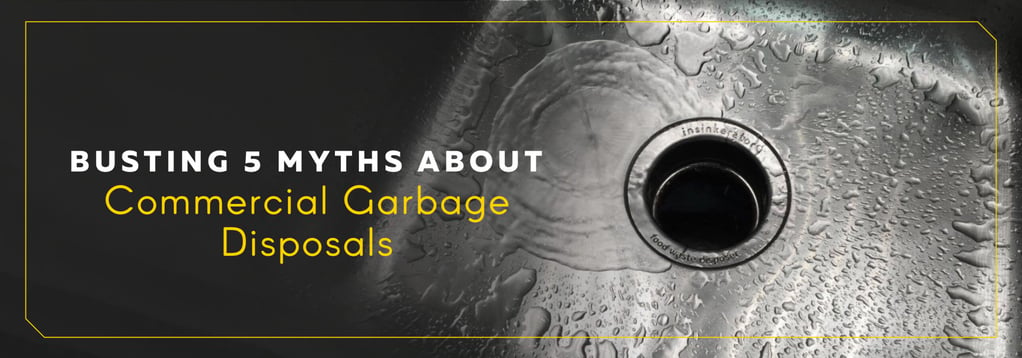
Busting Garbage Disposal Myths
While every restaurant owner should attempt to minimize his or her establishment's food waste, it is inevitable that some waste will occur. How you choose to handle it in your establishment can impact your kitchen's workflow, your restaurant's bottom line, and the environment. The pros and cons of garbage disposals have been hotly debated, with some cities going so far as to ban sink disposals1, though those bans were all lifted by 2008. With all the legal and environmental debates surrounding garbage disposals, some myths about their potential drawbacks have been propagated. Below we'll address some of those myths and present some facts on garbage disposals and their benefits.
- Myth: Food Waste Should Just Go to a Landfill
While it is perfectly legal for food to be disposed of in a landfill, it is not preferable in most cases and can be detrimental to the environment. When food is sent to a landfill, it produces methane as it decomposes, a gas at least 20 times more damaging to the atmosphere than carbon dioxide. Disposing of food with a garbage disposal instead creates a food slurry that is sent to your local wastewater plant, many of which harvest the scraps to use for renewable energy and/or fertilizer.2 Adding a garbage disposal to your commercial or residential kitchen is an easy way to lessen your carbon footprint.
- Myth: Food Waste is Bad for Wastewater Treatment Plants
This myth manages to persist despite the exact opposite being true in most cases. Of course, every local treatment plant is different, but for the most part, modern wastewater treatment facilities have adapted to capture particulates and make use of solid waste. In some cases, it can be made into a biofuel, which is used to generate energy – as much as 10 times the energy required to actually treat the water, according to a study done by the Massachusetts Department of Environmental Protection.3 If you're concerned about your food disposal's potential impact, contact someone at your local wastewater treatment plant to discuss their methods for dealing with food waste and what you're approved to send down your garbage disposal.
- Myth: Garbage Disposals are a Major Contributor to FOG Accumulation
FOG (fat, oil, and grease) accumulation is an important topic of discussion in restaurants. FOG deposits can build up in sewage lines, causing damage and blockages that can cost the restaurant or government thousands of dollars to repair. To help mitigate this damage, many cities have implemented regulations that require restaurants to use grease traps to reduce the amount of FOG that ends up in the pipes.
Some opponents of sink disposals have claimed the systems contribute to FOG accumulation, but a study on the composition of FOG deposits from several cities around the country found that claim to be untrue. The study found that most of the fats and oils in the FOG deposits had actually come from restaurants incorrectly disposing of fryer oil.4 To help keep your local sewer system healthy, use a shortening disposal unit if you use a commercial deep fryer. As long as you follow the manufacturer's recommendations and don't freely dump fat through your garbage disposal, you can use it without worrying about any damage to pipes.
- Myth: Trash Containers are an Easier Food Disposal Method
Dumping food waste in a trash can sounds easy enough, but that's only the first step. Most local health code regulations require dedicated buckets or barrels for food waste collection in order to prevent confusion that could lead to unsafe food being served. These dedicated receptacles take up extra space and must be completely covered and leakproof to prevent foul smells. They must also be emptied regularly, several times a day in some locations. Outdoor collection bins must be carefully maintained and collected frequently to prevent decomposing food from attracting pests, especially in the summer.5 In comparison, washing food down a garbage disposal seems simple.
- Myth: Garbage Disposals Waste Water and Power
Food disposals do require water and power to operate, but their usage is not as much as detractors might have you believe. Food disposal accessories such as flow control valves and Insinkerator's Aqua Saver Systems to help reduce water waste. A water management district in Florida suggests that conservation-conscious restaurants can even use the rinse water from washing dishes to flush food down the sink disposal.6 When it comes to electricity, a garbage disposal uses less than most commercial microwaves, and any additional costs may be offset by the savings you will reap from reduced trash pickup.
References
- Ban on Garbage Disposals? Green Building Elements. Accessed April 2016.
- What's Better for Food Waste?. Science 2.0. Accessed April 2016.
- Tapping the Energy Potential of Municipal Wastewater Treatment. Massachusetts Department of Environmental Protection. Accessed April 2016.
- Properties Influencing Fat, Oil, and Grease Deposit Formation. Water Environment Federation. Accessed April 2016.
- Commercial Food Waste Separation. Recycling Works. Accessed April 2016.
- Water Conservation Checklist. Southwest Florida Water Management District. Accessed December 2022.
